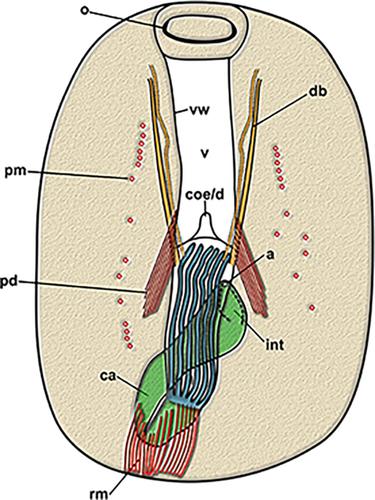当前位置:
X-MOL 学术
›
J. Morphol.
›
论文详情
Our official English website, www.x-mol.net, welcomes your feedback! (Note: you will need to create a separate account there.)
Morphology of ctenostome bryozoans: 2. Haywardozoon pacificum , with implications of the phylogenetic position of the genus
Journal of Morphology ( IF 1.5 ) Pub Date : 2020-09-21 , DOI: 10.1002/jmor.21272 Thomas Schwaha 1 , Andrei V Grischenko 2, 3 , Viacheslav P Melnik 4
Journal of Morphology ( IF 1.5 ) Pub Date : 2020-09-21 , DOI: 10.1002/jmor.21272 Thomas Schwaha 1 , Andrei V Grischenko 2, 3 , Viacheslav P Melnik 4
Affiliation

|
The genus Haywardozoon represent a little known genus of ctenostome bryozoans that has only been found in the deep‐sea. It forms small, mostly uniserial colonies lacking polymorphs. Zooids have a conspicuous apertural closure mechanism consisting of a cuticular lower lip that closes the aperture. The systematic placement of the genus remains uncertain, detailed morphological studies that include soft‐body morphological traits are missing. Consequently, this is the first study analyzing H. pacificum by means of histological serial sections and 3d‐reconstruction. Zooids are ovoid and in some cases solitary, that is, showing no interconnected zooids. Most prominent is the large vestibular wall that can be more than half of the total length of the zooid. Its vestibular wall is particularly lined by a complex, multilayered and branched cuticle. A single pair of lateral parieto‐diaphragmatic muscles is present. The polypide is small and comprises about 17 tentacles. The digestive tract is short, has an elongated cardia, a vestigial caecum and a vestibular anus. An ovipositor/intertentacular organ and several oligolecithal oocytes were detected. Several aspects of zooidal morphology, including the structure of the bilateral aperture, parieto‐diaphragmatic muscles, general structure of the gut and the thick cuticle, clearly indicate an association to the ctenostome superfamily Alcyonidioidea. Therefore, we reject the previous placement into Hislopioidea and suggest a possible association to pherusellid ctenostomes. New reproductive characters show that H. pacificum is a broadcaster contrary to some other deep‐sea forms that are brooding.
中文翻译:

ctenostome 苔藓虫的形态学:2. Haywardozoon pacificum,与该属的系统发育位置有关
Haywardozoon 属是一种鲜为人知的 ctenostome 苔藓虫属,仅在深海中发现过。它形成小的,主要是缺乏多态性的单序列菌落。Zooids 有一个显着的孔闭合机制,由关闭孔的表皮下唇组成。该属的系统位置仍然不确定,缺少包括软体形态特征的详细形态学研究。因此,这是第一项通过组织学连续切片和 3d 重建分析 H. pacificum 的研究。Zooids是卵形的,在某些情况下是单独的,也就是说,没有相互关联的zooids。最突出的是大前庭壁,可以超过整个动物体总长度的一半。它的前庭壁特别衬有复杂的、多层的和分枝的角质层。存在一对外侧顶膈肌。息肉很小,大约有 17 个触角。消化道很短,有一个细长的贲门、一个残留的盲肠和一个前庭肛门。检测到一个产卵器/触须间器官和几个寡卵磷脂卵母细胞。动物形态的几个方面,包括双侧孔的结构、顶膈肌、肠道的一般结构和厚的角质层,清楚地表明与栉水口总科 Alcyonidioidea 的关联。因此,我们拒绝先前放入 Hislopioidea 并建议与 pherusellid ctenostomes 的可能关联。新的繁殖特征表明,H. pacificum 是一种与其他一些正在孵化的深海形式相反的传播者。
更新日期:2020-09-21
中文翻译:

ctenostome 苔藓虫的形态学:2. Haywardozoon pacificum,与该属的系统发育位置有关
Haywardozoon 属是一种鲜为人知的 ctenostome 苔藓虫属,仅在深海中发现过。它形成小的,主要是缺乏多态性的单序列菌落。Zooids 有一个显着的孔闭合机制,由关闭孔的表皮下唇组成。该属的系统位置仍然不确定,缺少包括软体形态特征的详细形态学研究。因此,这是第一项通过组织学连续切片和 3d 重建分析 H. pacificum 的研究。Zooids是卵形的,在某些情况下是单独的,也就是说,没有相互关联的zooids。最突出的是大前庭壁,可以超过整个动物体总长度的一半。它的前庭壁特别衬有复杂的、多层的和分枝的角质层。存在一对外侧顶膈肌。息肉很小,大约有 17 个触角。消化道很短,有一个细长的贲门、一个残留的盲肠和一个前庭肛门。检测到一个产卵器/触须间器官和几个寡卵磷脂卵母细胞。动物形态的几个方面,包括双侧孔的结构、顶膈肌、肠道的一般结构和厚的角质层,清楚地表明与栉水口总科 Alcyonidioidea 的关联。因此,我们拒绝先前放入 Hislopioidea 并建议与 pherusellid ctenostomes 的可能关联。新的繁殖特征表明,H. pacificum 是一种与其他一些正在孵化的深海形式相反的传播者。



























 京公网安备 11010802027423号
京公网安备 11010802027423号